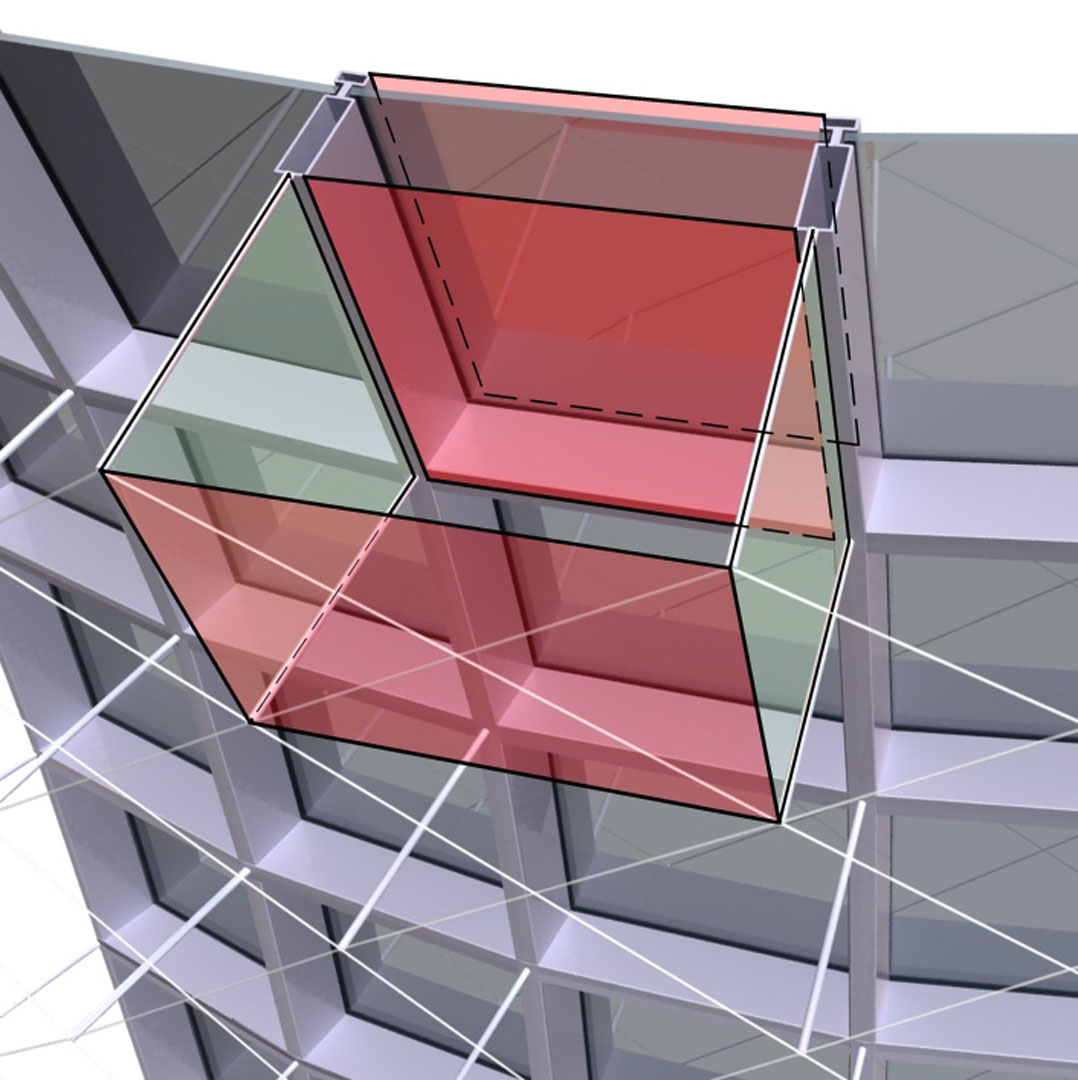“Geometric modeling with conical meshes and developable surfaces” by Liu, Pottmann, Wallner, Yang and Wang
Conference:
Type(s):
Title:
- Geometric modeling with conical meshes and developable surfaces
Presenter(s)/Author(s):
Abstract:
In architectural freeform design, the relation between shape and fabrication poses new challenges and requires more sophistication from the underlying geometry. The new concept of conical meshes satisfies central requirements for this application: They are quadrilateral meshes with planar faces, and therefore particularly suitable for the design of freeform glass structures. Moreover, they possess a natural offsetting operation and provide a support structure orthogonal to the mesh. Being a discrete analogue of the network of principal curvature lines, they represent fundamental shape characteristics. We show how to optimize a quad mesh such that its faces become planar, or the mesh becomes even conical. Combining this perturbation with subdivision yields a powerful new modeling tool for all types of quad meshes with planar faces, making subdivision attractive for architecture design and providing an elegant way of modeling developable surfaces.
References:
1. Alliez, P., Cohen-Steiner, D., Devillers, O., Levy, B., and Desbrun, M. 2003. Anisotropic polygonal remeshing. ACM Trans. Graphics 22, 3, 485–493.]] Google ScholarDigital Library
2. Aumann, G. 2004. Degree elevation and developable Bézier surfaces. Comp. Aided Geom. Design 21, 661–670.]] Google ScholarDigital Library
3. Blake, A., and Isard, M. 1998. Active Contours. Springer.]]Google Scholar
4. Bobenko, A., and Suris, Y., 2005. Discrete differential geometry. Consistency as integrability. preprint, http://arxiv.org/abs/math.DG/0504358.]]Google Scholar
5. Bobenko, A., Matthes, D., and Suris, Y. 2003. Discrete and smooth orthogonal systems: C∞-approximation. Int. Math. Res. Not., 45, 2415–2459.]]Google ScholarCross Ref
6. Bobenko, A., Hoffmann, T., and Springborn, B. A. 2006. Minimal surfaces from circle patterns: Geometry from combinatorics. Annals of Mathematics 164, 231–264.]]Google ScholarCross Ref
7. Cecil, T. 1992. Lie Sphere Geometry. Springer.]]Google Scholar
8. Cerda, E., Chaieb, S., Melo, F., and Mahadevan, L. 1999. Conical dislocations in crumpling. Nature 401, 46–49.]]Google ScholarCross Ref
9. Chen, Y., and Medioni, G. 1991. Object modeling by registration of multiple range images. In Proc. IEEE Conf. on Robotics and Automation.]]Google Scholar
10. Chu, C. H., and Sequin, C. 2002. Developable Bézier patches: properties and design. Computer-Aided Design 34, 511–528.]]Google ScholarCross Ref
11. Cipolla, R., and Giblin, P. 2000. Visual Motion of Curves and Surfaces. Cambridge University Press.]] Google ScholarDigital Library
12. Clarenz, U., Rumpf, M., and Telea, A. 2004. Robust feature detection and local classification for surfaces based on moment analysis. IEEE Trans. Visual. Comp. Graphics 10, 516–524.]] Google ScholarDigital Library
13. Cohen-Steiner, D., and Morvan, J.-M. 2003. Restricted Delaunay triangulations and normal cycle. In Proc. 19th annual symposium on Computational geometry, ACM, 312–321.]] Google ScholarDigital Library
14. Cohen-Steiner, D., Alliez, P., and Desbrun, M. Variational shape approximation. ACM Trans. Graphics 23, 3, 905–914.]] Google ScholarDigital Library
15. Desbrun, M., Grinspun, E., and Schröder, P. 2005. Discrete Differential Geometry. SIGGRAPH Course Notes.]]Google Scholar
16. do Carmo, M. 1976. Differential Geometry of Curves and Surfaces. Prentice-Hall.]]Google Scholar
17. Dong, S., Kircher, S., and Garland, M. 2005. Harmonic functions for quadrilateral remeshing of arbitrary manifolds. Comp. Aided Geom. Design 22, 392–423.]]Google ScholarDigital Library
18. Frey, W. 2004. Modeling buckled developable surfaces by triangulation. Computer-Aided Design 36, 4, 299–313.]]Google ScholarCross Ref
19. Glymph, J., Shelden, D., Ceccato, C., Mussel, J., and Schober, H. 2002. A parametric strategy for freeform glass structures using quadrilateral planar facets. In Acadia 2002, ACM, 303–321.]]Google Scholar
20. Hildebrandt, K., Polthier, K., and Wardetzky, M. 2005. On the convergence of metric and geometric properties of polyhedral surfaces. Tech. Rep. 05–24, Zuse Institute Berlin.]]Google Scholar
21. Julius, D., Kraevoy, V., and Sheffer, A. 2005. D-charts: Quasi-developable mesh segmentation. Computer Graphics Forum (Proc. Eurographics 2005) 24, 3, 581–590.]]Google Scholar
22. Kelley, C. T. 1999. Iterative Methods for Optimization. SIAM.]]Google Scholar
23. Kilian, A. 2006. Design exploration through bidirectional modeling of constraints. PhD thesis, Massachusets Inst. Technology.]] Google ScholarDigital Library
24. Kim, S.-J., and Yang, M.-Y. 2005. Triangular mesh offset for generalized cutter. Computer-Aided Design 37, 10, 999–1014.]] Google ScholarDigital Library
25. Madsen, K., Nielsen, H. B., and Tingleff, O., 2004. Optimization with constraints. Lecture Notes.]]Google Scholar
26. Marinov, M., and Kobbelt, L. 2004. Direct anisotropic quad-dominant remeshing. In Proc. Pacific Graphics, 207–216.]] Google ScholarDigital Library
27. Martin, R. R., de Pont, J., and Sharrock, T. J. 1986. Cyclide surfaces in computer aided design. In The mathematics of surfaces, J. A. Gregory, Ed. Clarendon Press, Oxford, 253–268.]]Google Scholar
28. Mitani, J., and Suzuki, H. 2004. Making papercraft toys from meshes using strip-based approximate unfolding. ACM Trans. Graphics 23, 3, 259–263.]] Google ScholarDigital Library
29. Polthier, K. 2002. Polyhedral surfaces of constant mean curvature. Habilitationsschrift TU Berlin.]]Google Scholar
30. Porteous, I. R. 1994. Geometric Differentiation for the Intelligence of Curves and Surfaces. Cambridge Univ. Press.]]Google Scholar
31. Pottmann, H., and Wallner, J. 2001. Computational Line Geometry. Springer.]] Google ScholarDigital Library
32. Pottmann, H., Huang, Q.-X., Yang, Y.-L., and Kölpl, S., 2005. Integral invariants for robust geometry processing. Geometry Preprint 146, TU Wien.]]Google Scholar
33. Ray, N., Li, W.-C., Levy, B., Sheffer, A., and Alliez, P., 2005. Periodic global parameterization. INRIA preprint.]] Google ScholarDigital Library
34. Sauer, R. 1970. Differenzengeometrie. Springer.]]Google Scholar
35. Sequin, C. 2004. CAD tools for aesthetic engineering. CAD & Appl. 1, 301–309.]]Google Scholar
36. Sullivan, J. 2005. The aesthetic value of optimal geometry. In In The Visual Mind II, M. Emmer, Ed. MIT Press, 547–563.]]Google Scholar
37. Wang, C., and Tang, K. 2004. Achieving developability of a polygonal surface by minimum deformation: a study of global and local optimization approaches. Vis. Computer 20, 521–539.]] Google ScholarDigital Library
38. Wang, W., Wallner, J., and Liu, Y., 2006. An angle criterion for conical mesh vertices. Geometry Preprint 157, TU Wien. http://www.geometrie.tuwien.ac.at/ig/papers/tr157.pdf.]]Google Scholar
39. Wunderlich, W. 1951. Zur Differenzengeometrie der Flächen konstanter negativer Krümmung. Sitz. öst. Ak. Wiss. 160, 41–77.]]Google Scholar
40. Yamauchi, H., Gumhold, S., Zayer, R., and Seidel, H.-P. 2005. Mesh segmentation driven by Gaussian curvature. Visual Computer 21, 659–668.]]Google ScholarCross Ref




